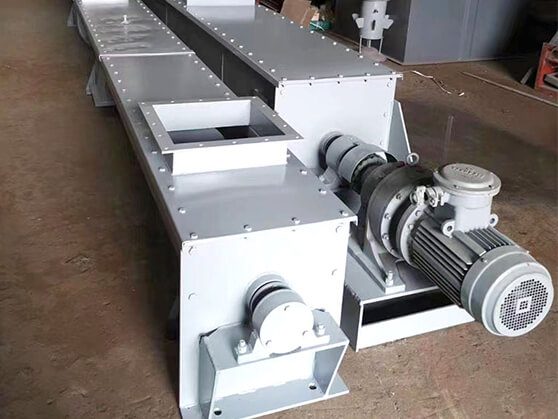The U-type screw conveyor is made of high-quality steel. It is widely used in various industries, including chemicals, construction, grain, and food. This equipment is suitable for transporting high-temperature powders or solid particles. Its flexible design and efficient performance make it an ideal choice for material transport. Whether for horizontal, inclined, or vertical transport, the U-type screw conveyor provides reliable solutions to help customers improve productivity.
Design and Specifications
The U-type screw conveyor has a diameter range of 200 mm to 500 mm. It comes in five specifications, with lengths from 4 meters to 70 meters. Users can choose from increments of 0.5 meters. The transmission parts use floating connections, and the bearing design features a universal joint structure. This allows the system to rotate freely within a certain range, avoiding material blockages.
Working Principle
The U-type screw conveyor works by using a rotating screw to push materials along a fixed casing. The bearings at the head and tail are located outside the casing. The hanging bearing has a dust-proof sealing device, ensuring efficient operation. Users can select suitable models based on different process requirements, such as horizontal slow screw conveyors or vertical fast screw conveyors.
Main Features
The U-type screw conveyor has several key features:
- Compact Size and High Speed: It ensures fast and even material transport.
- Strong Rigidity and Good Sealing: It is made of seamless steel pipes, with a sturdy and well-sealed casing.
- Low Noise: The discharge end has a cleaning device, and the layout of inlets and outlets is flexible.
- High Load Capacity: It is safe and reliable for various working conditions.
- Easy Maintenance: The equipment has a long service life and is easy to install and maintain.
Usage Notes
When using the U-type screw conveyor, users should follow these guidelines to ensure efficient operation and extend the equipment’s life:
- Choose the Right Conveyor Belt: Select the appropriate type, structure, and layers based on usage and equipment compatibility.
- Keep It Clean: Maintain cleanliness during transport and storage. Avoid direct sunlight, rain, and contact with organic solvents.
- Avoid Mixing Different Specifications: Do not connect different types and specifications of conveyor belts. Use adhesive connections whenever possible.
- Control the Running Speed: Do not exceed a speed of 2.5 meters per second. Use low speeds to reduce wear.
- Select Suitable Components: Choose rollers and brackets according to design specifications.
- Provide Adequate Buffering: Use buffer rollers and soft side boards to prevent material leakage and damage to the conveyor belt.
Maintenance and Testing Notes
After maintenance, users should pay attention to the following during testing:
- Maintain Gap Between Components: Ensure the gap between the bearing end face and the connecting flange meets specifications based on screw diameter.
- Ensure Equal Gaps: The gap between the casing wall and the screw should be equal and within the allowable range.
- Install Suspended Bearings Correctly: Place the suspended bearing at the midpoint of the connecting shaft, ensuring proper gaps.
- Check for Oil Leaks: If oil leaks are found, adjust the seals to stop the leaks.

Application and Limitations
The U-type screw conveyor is powerful, but it is not suitable for transporting materials that easily spoil, are highly viscous, or tend to clump. Such materials may stick to the screw during transport, preventing forward movement and causing blockages at the bearing. Therefore, users should consider material characteristics and working environments when selecting a conveyor.
If you are interested in the U-type screw conveyor or other conveying equipment, Darko specializes in high-quality conveying solutions to meet your needs. Please feel free to contact us. We are here to help you find the best conveying solutions.

